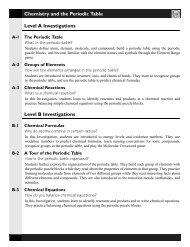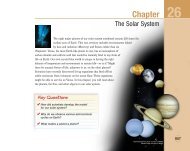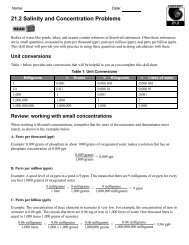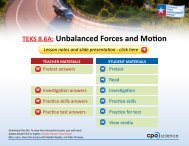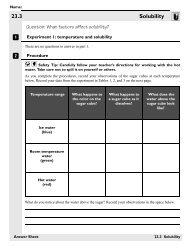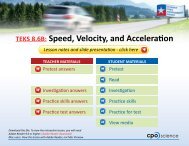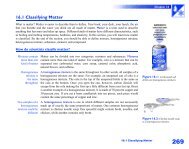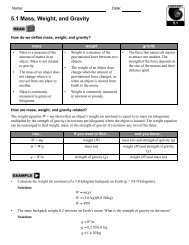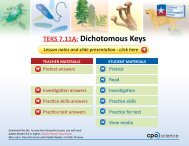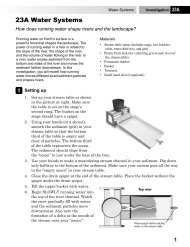Time, Distance, and Speed - CPO Science
Time, Distance, and Speed - CPO Science
Time, Distance, and Speed - CPO Science
You also want an ePaper? Increase the reach of your titles
YUMPU automatically turns print PDFs into web optimized ePapers that Google loves.
Name: ______________________________________________<br />
<strong>Time</strong>, <strong>Distance</strong>, <strong>and</strong> <strong>Speed</strong><br />
A<br />
Using the timer as a stopwatch<br />
There are no questions to answer in part 1.<br />
B<br />
Mixed units for time<br />
Arrange the following times from smallest to largest:<br />
Date: __________<br />
1A<br />
C<br />
Using the photogates<br />
There are no questions to answer in part 3.<br />
D<br />
How the photogate works<br />
a. Exactly what do you do to start <strong>and</strong> stop the clock Be very specific in your answer. Someone who has<br />
never seen the photogate before should be able to read your answer <strong>and</strong> know what to do.<br />
b. If you block the light beam several times in a row, does the time add or does the timer start at zero<br />
every time you break the beam Your answer should provide observations that back up what you say.<br />
For example, “the timer does _____ because_____.” Fill in the blanks with what you think based on<br />
what you observed.<br />
1
Name: ______________________________________________<br />
E<br />
A<br />
light<br />
Two photogates<br />
B<br />
light<br />
How do you start the<br />
clock<br />
Table 1: <strong>Time</strong>r <strong>and</strong> photogate rules<br />
How do you stop the<br />
clock<br />
Date: __________<br />
What time interval does<br />
the clock measure<br />
1A<br />
On<br />
Off<br />
On<br />
Off<br />
Off<br />
On<br />
On<br />
Off<br />
F<br />
Thinking about what you observed<br />
a. Describe a way to measure the speed of a toy car using two photogates <strong>and</strong> a meter stick.<br />
b. Describe a way to measure the speed of a toy car using one photogate <strong>and</strong> a meter stick.<br />
c. What does the red Reset button do<br />
G<br />
Constant speed<br />
There are no questions to answer in part 7.<br />
2
Name: ______________________________________________<br />
H<br />
Thinking about what you observed<br />
Date: __________<br />
a. Describe how the photogate measurements prove that the car has constant speed, or nearly<br />
constant speed.<br />
1A<br />
b. Calculate the speed of the car in meters per second (m/sec).<br />
I Position versus time Table 2: Position versus time data<br />
Position<br />
(cm)<br />
<strong>Time</strong> through<br />
photogate A<br />
(sec.)<br />
<strong>Time</strong> through<br />
photogate A<br />
(sec.)<br />
<strong>Time</strong> from photogate<br />
A to B<br />
(sec.)<br />
3
Name: ______________________________________________<br />
J<br />
Thinking about what you observed<br />
Date: __________<br />
a. Draw a graph showing the position of the car on the vertical (y) axis <strong>and</strong> the time since the car<br />
was released on the horizontal (x) axis. The time you want is the time from photogate A to B.<br />
1A<br />
b. What shape does the position versus time graph have Describe the line or curve that you produce.<br />
c. Calculate the average speed of the car from the graph or your data.<br />
d. How long would it take the car to travel a distance of 2 meters if it kept the same speed<br />
4
Name: ______________________________________________ Date: __________<br />
Systems, Energy <strong>and</strong> Change<br />
A<br />
Making a system<br />
There are no questions to answer in part 1.<br />
B<br />
Questions for the experiment<br />
a. What is speed <strong>and</strong> how can it be measured with two photogates in this experiment<br />
1B<br />
b. Different cars are rolling on tracks with different angles. Which car should go the fastest Which car<br />
should go the slowest<br />
c. Which car should have the shortest time from photogate A to photogate B Which should have the<br />
longest time<br />
C<br />
What do you observe<br />
Each group should drop the car <strong>and</strong> record the time it takes to get from photogate A to photogate B. Use<br />
Table 2 to record the times in the Trial #1 column. Leave the second column black for now.<br />
Table 1: <strong>Speed</strong> data<br />
Hole # Trial #1<br />
<strong>Time</strong> in seconds<br />
Trial #2<br />
<strong>Time</strong> in seconds<br />
1
Name: ______________________________________________ Date: __________<br />
D<br />
Thinking about what you observed<br />
a. Did the times in Table 1 agree with your hypothesis Explain in one sentence why or why not.<br />
1B<br />
b. What objects <strong>and</strong> influences should be “in” your system if you want to investigate the motion of the<br />
car<br />
c. Name two things that should not be in your system since they do not influence the motion.<br />
d. What is a variable What variables affect the motion of the car in your system Make a list of the<br />
variables (Hint: there are at least 6 important ones).<br />
e. What variable is being tested in your class experiment (the experimental variable) How do you know<br />
f. What should be done with the other variables which are not the experimental variable Why<br />
E<br />
A better experiment<br />
Enter the data into table 1.<br />
2
Name: ______________________________________________<br />
F<br />
Thinking about what you observed<br />
Date: __________<br />
a. Did the new times for the second trial of the experiment agree with your hypothesis about<br />
which track should have the fastest car Explain in one sentence why or why not.<br />
1B<br />
G<br />
Energy in the system<br />
Drop<br />
position<br />
(cm from<br />
center)<br />
Table 2: Energy data<br />
Before rubber b<strong>and</strong><br />
<strong>Time</strong><br />
through<br />
photogate<br />
(sec)<br />
<strong>Speed</strong><br />
(cm/sec)<br />
After rubber b<strong>and</strong><br />
<strong>Time</strong><br />
through<br />
photogate<br />
(sec)<br />
<strong>Speed</strong><br />
(cm/sec)<br />
H<br />
Thinking about what you observed<br />
a. If you drop the car from a certain height does it ever go higher after bouncing off the rubber b<strong>and</strong><br />
b. If the car has a certain speed going into the rubber b<strong>and</strong> does it ever have a greater speed after bouncing<br />
off (Hint: use the timer’s memory button.)<br />
3
Name: ______________________________________________<br />
Date: __________<br />
c. When you drop the car from a certain height it reaches a certain speed at the photogate. If you<br />
launch the car with the same speed back up the hill, does the car ever get higher than the height<br />
at which you first dropped it (try this experiment)<br />
1B<br />
d. In one paragraph, explain how the answers to a, b, <strong>and</strong> c are explained using the idea of energy.<br />
4
Name: ______________________________________________<br />
The Law of Inertia<br />
A<br />
Launching cars of different mass<br />
Mass of car (kg)<br />
Table 1: Constant force data<br />
<strong>Time</strong> through photogate<br />
(sec)<br />
Date: __________<br />
<strong>Speed</strong><br />
(m/sec)<br />
2A<br />
B<br />
Thinking about what you observed<br />
a. Use Table 1 to graph the speed of the car (y) against the mass (x).<br />
b. Why did the speed change when the same launching force from the rubber b<strong>and</strong> was applied to cars of<br />
different mass How do your observations support your answer<br />
1
Name: ______________________________________________<br />
C<br />
Inertia <strong>and</strong> weight<br />
Mass of car (kg)<br />
Table 2: Constant height data<br />
<strong>Time</strong> through photogate<br />
(sec)<br />
Date: __________<br />
<strong>Speed</strong><br />
(m/sec)<br />
2A<br />
D<br />
Thinking about what you observed<br />
a. What force makes the car go down the hill What property of matter does this force act upon<br />
b. Does increasing the mass of the car increase its speed by a proportional amount Does the speed<br />
decrease with increasing mass Does the speed stay about the same, no matter what the mass<br />
c. Discuss <strong>and</strong> propose an explanation for why changing the mass has a very different effect on the speed<br />
when gravity provides the force compared to when the force is provided by a rubber b<strong>and</strong>.<br />
2
Name: ______________________________________________<br />
Date: __________<br />
d. Research <strong>and</strong> define the terms “inertia”, “weight” <strong>and</strong> “mass”. Write 2-3 sentences that<br />
describe how these three concepts are similar <strong>and</strong> how they are different.<br />
2A<br />
3
Name: ______________________________________________<br />
Newton’s Second Law<br />
A<br />
Looking at the motion along the track<br />
<strong>Time</strong> photogate<br />
A<br />
(sec)<br />
Table 1: <strong>Speed</strong> data<br />
<strong>Time</strong> photogate<br />
B<br />
(sec)<br />
<strong>Time</strong> from A<br />
to B<br />
sec)<br />
Date: __________<br />
<strong>Speed</strong> at A<br />
(m/sec)<br />
2B<br />
<strong>Speed</strong> at B<br />
(m/sec)<br />
Level section<br />
B<br />
Down hill section<br />
Thinking about what you observed<br />
a. Where is there a net force acting on the car How do you know<br />
b. Where is there zero net force on the car How do you know<br />
c. Can you have constant speed with zero net force What experimental data support your answer<br />
1
Name: ______________________________________________<br />
Date: __________<br />
d. Write down a formula for the acceleration of the car in terms of the speeds at photogates A <strong>and</strong><br />
B <strong>and</strong> the time from A to B.<br />
2B<br />
e. Calculate the acceleration of the car in m/sec 2 on both the level section <strong>and</strong> the downhill section.<br />
f. Explain the difference in acceleration between the level <strong>and</strong> downhill sections using Newton’s second<br />
law <strong>and</strong> the concept of force.<br />
C <strong>Speed</strong> <strong>and</strong> time graphs Table 2: <strong>Speed</strong> versus time data<br />
Position<br />
(cm)<br />
<strong>Time</strong> through<br />
A (sec)<br />
<strong>Time</strong> through<br />
B<br />
(sec)<br />
<strong>Time</strong> from<br />
A to B<br />
(sec)<br />
<strong>Speed</strong> at A<br />
(m/sec)<br />
<strong>Speed</strong> at B<br />
(m/sec)<br />
2
Name: ______________________________________________<br />
D<br />
Thinking about what you observed<br />
Date: __________<br />
a. Draw the graph of speed vs. time for the track. For the x-axis use the time from photogate A<br />
to B.<br />
2B<br />
b. Use Newton’s second law to calculate the force acting on the car at each position. Measure the<br />
acceleration from your speed vs. time graph. Where does the force come from<br />
Position:<br />
Force:<br />
3
Name: ______________________________________________<br />
Date: __________<br />
c. Draw the graph of force vs. time <strong>and</strong> compare this graph to the speed vs. time graph.<br />
2B<br />
What relationship is there between the two graphs<br />
d. Explain how speed <strong>and</strong> acceleration are different using your speed vs. time graph as an example.<br />
4
Name: ______________________________________________<br />
Momentum <strong>and</strong> the Third Law<br />
A<br />
Making a collision<br />
There are no questions to answer in part 1.<br />
B<br />
Thinking about what you observed.<br />
Mass of<br />
target car<br />
(kg)<br />
Mass of<br />
rolling<br />
car<br />
(kg)<br />
Rolling car before<br />
collision<br />
Photogat<br />
e<br />
(sec)<br />
Table 1: Collision data<br />
<strong>Speed</strong><br />
(m/sec)<br />
Rolling car after<br />
collision<br />
Photogat<br />
e<br />
(sec)<br />
<strong>Speed</strong><br />
(m/sec)<br />
Date: __________<br />
Target car after<br />
collision<br />
Photogat<br />
e<br />
(sec)<br />
3A<br />
<strong>Speed</strong><br />
(m/sec)<br />
a. Consider two colliding cars of equal mass. Describe in words the motion of the two cars before <strong>and</strong><br />
after the collision.<br />
1
Name: ______________________________________________<br />
Date: __________<br />
b. The target car must exert a force on the rolling car to stop it. How strong is this force relative to<br />
the force the rolling car exerts on the target car to get it moving What experimental evidence<br />
supports your answer<br />
3A<br />
c. Look up Newton’s third law <strong>and</strong> state how it applies to the collision of the two cars.<br />
C Momentum<br />
There are no questions to answer in part 3.<br />
D<br />
Thinking about what you observed<br />
a. Describe the motion of the two cars when the target car has more mass than the rolling car.<br />
b. Describe the motion of the two cars when the target car has less mass than the rolling car.<br />
c. Research <strong>and</strong> write down a formula for the momentum of a moving object. State what each of the<br />
variables are <strong>and</strong> what units they have.<br />
2
Name: ______________________________________________<br />
Date: __________<br />
d. Calculate the total momentum of the two cars before <strong>and</strong> after each collision. Be sure to<br />
remember that momentum can be positive or negative depending on the direction of motion.<br />
3A<br />
Trial Momentum before collision Momentum after collision<br />
1<br />
2<br />
3<br />
4<br />
5<br />
6<br />
7<br />
8<br />
9<br />
e. Research <strong>and</strong> write down the law of conservation of momentum. Describe how your data either support<br />
or do not support this law.<br />
3
.<br />
Name: ______________________________________________ Date: __________<br />
Conservation of Energy<br />
A<br />
Energy exchange from potential to kinetic<br />
Table 1: Downhill data<br />
Drop Height (m) Mass of car (kg) Photogate time (sec) <strong>Speed</strong> (m/sec)<br />
3B<br />
1
Name: ______________________________________________ Date: __________<br />
B<br />
Thinking about what you observed<br />
a. Graph the speed of the car vs. the height. Use different symbols for different masses.<br />
3B<br />
b. What does the graph tell you about the relationship between speed <strong>and</strong> height<br />
C<br />
Analyzing the data<br />
a. Use the formula for potential energy to fill in the first column of Table 2.<br />
b. Use energy conservation to derive a formula for the speed of the car in terms of the energy it has at the<br />
start. (Hint: your formula should include only two variables, energy <strong>and</strong> height.)<br />
c. Use the formula you just derived to fill in the column for the predicted speed of the car.<br />
2
Name: ______________________________________________<br />
Date: __________<br />
d. Plot the curve for the predicted speed on the same graph as you made in part 2a above.<br />
Drop Height (m)<br />
Table 2: Energy data <strong>and</strong> predicted speeds<br />
Potential energy<br />
(J)<br />
Predicted speed<br />
(m/sec)<br />
3B<br />
Measured speed from<br />
Table 1<br />
(m/sec)<br />
D<br />
Thinking about what you observed<br />
a. Explain the relationship between speed <strong>and</strong> height using the idea of energy conservation.<br />
b. Explain any difference between the predicted <strong>and</strong> measured speeds. If there is a difference, what does it<br />
tell you about the energy of the car as it rolls along the track<br />
3
Name: ______________________________________________<br />
Date: __________<br />
c. Did changing the mass have a significant effect on the relationship between height <strong>and</strong> speed<br />
How does your data support your answer<br />
3B<br />
d. Let the car roll downhill, bounce off the rubber b<strong>and</strong> <strong>and</strong> go back up hill again. Does it reach the same<br />
height as it was dropped from Explain why or why not using the idea of energy conservation.<br />
e. Challenge experiment. Use a rubber b<strong>and</strong> to launch the car uphill so it goes through the photogate with<br />
the same speed as it had going down. You won’t be able to get it precisely the same, but come as close<br />
as you can. If the speeds are the same, the car’s kinetic energy is also the same. Does the car reach the<br />
same height on the hill that it was dropped from to get the same speed in part 1 Explain any difference<br />
using the idea of energy lost to friction.<br />
4



